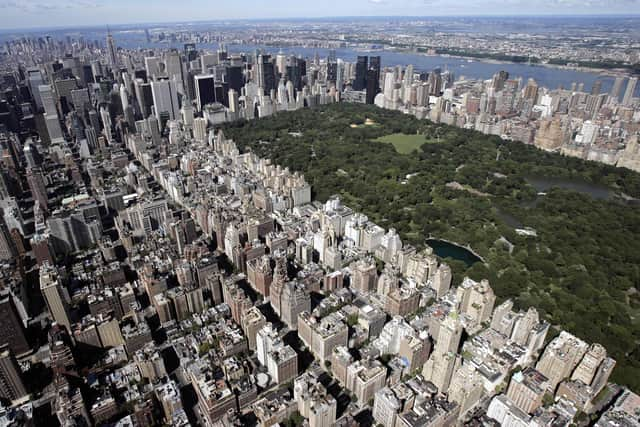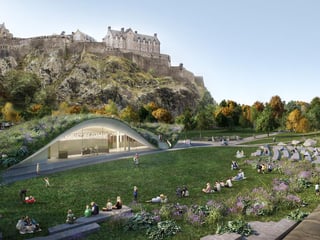Edinburgh can learn from genius behind New York City’s Central Park– Joe Goldblatt


Frederick Law Olmsted served as the principal designer of New York City’s Central Park, over 6000 other parks throughout the world and the 1893 Chicago World’s Fair. His design theories may well serve as guide to help our Capital city move forward from the perfect planning storm we are currently experiencing, concerning the current and future development of Princes Street Gardens, the Royal High School, and our public performances through the Edinburgh Christmas and our summer festivals.
It is vitally important to carefully look back in order to move forward with confidence. The current conundrum that the citizens of Edinburgh face with planning is one of competing interests versus a better and more sustainable public place future for all.
Advertisement
Hide AdAdvertisement
Hide AdOne example of this is the debate concerning the future use of the Royal High School site. I support the development of a luxury hotel upon this site in order that hundreds of young people may have future employment and provide new tax income for our city.


Other citizens prefer the development of a music school that will provide instruction for hundreds of young people that may contribute to the cultural life of our city.
Therefore, how may these two divergent ideas eventually coalesce to satisfy and benefit the entire city?
One solution is to follow Olmsted’s first lesson of respecting the genius of place. The Royal High School site is one of the most prominent in our city and would benefit from the development of an iconic building that serves as both a source of future revenue to benefit the entire city as well as a training academy for future hospitality and performing arts professionals.
Advertisement
Hide AdAdvertisement
Hide AdI have always believed that central to the field of hospitality is the theory of live performance. One example of this success is the G1 Group’s very successful Tennent’s Training Academy in Glasgow.
Tens of thousands of young people and mature workers have learned hospitality skills upon this campus and they have subsequently greatly enriched Scotland’s hospitality scene. The same formula could be integrated into a new hotel development to respect the genius of place and space could also be ring fenced to incorporate performing arts training as well as public live performances.
READ MORE: Forget Princes Street Gardens, I’m selling debentures for Susan’s Street Gardens – Susan Morrison
Olmsted also believed that designers must subordinate details to the whole. He did not believe in creating elaborate plantings and instead saw bridges, plantings and other details as threads in a larger fabric.
Advertisement
Hide AdAdvertisement
Hide AdHe favoured landscapes that were organic and true. Therefore, as the plans for both the Royal High School and Princes Street Gardens are debated perhaps it is time to draw a deep breath and ask how may all of the threads be woven together to create a stronger and more beautiful Scottish tartan of enduring design.
One example of this would be to embrace the concept of public use as compatible with private sponsorship and patronage rather than dismiss these ideas without further consideration.
The continuing conflicting views surrounding Edinburgh’s Christmas and our summer festivals are further examples of why we risk unravelling the uniqueness of our performance landscape in Edinburgh.
The city’s genius as a festival destination is the simultaneous delivery of multiple events that benefit both local citizens and our visitors through their diversity and quality. No other city in the world offers as many multiple experiences for education, artistic gratification, and perhaps most of all, for communal discourse, as does Edinburgh every summer.
Advertisement
Hide AdAdvertisement
Hide AdWe risk losing this genius for human development if we fail to subordinate details to the whole.
My favourite Olmsted lesson is that in design, the art is to conceal art. He described his experience in visiting the Isle of Wight when “gradually and suddenly the charm comes upon us; we know not exactly when or how”.
How many of us have had this sensation upon first looking up to Edinburgh Castle or standing upon Arthur’s Seat and surveying the beauty of Edinburgh and its countryside?
Any future design plans for our city must incorporate this lesson and that is why the proposed plans for the redevelopment of the Ross Bandstand and the other elements within Princes Street Gardens are, I firmly believe, well-conceived.
Advertisement
Hide AdAdvertisement
Hide AdThey organically, naturally and charmingly embrace the existing features of the Gardens and appear, as Olmsted wrote “Preserved by happenstance”.
I do not believe, and this has been proven in major cities throughout the world, that the offer of naming rights to individuals or organisations will impede this progress nor will this negatively restrict future public access.
The designer of New York’s Central Park rejected the term landscape gardener because he found it too confining. He embraced the opportunity to become a landscape architect and use his experience and skills to create public spaces that transported local citizens to places where they could experience their better angels.
Interestingly, Olmsted was not formally trained in landscape design. His training came from his experience of travelling the world and internalising the vistas he saw and applying these memories to his future designs.
Advertisement
Hide AdAdvertisement
Hide AdHe once stated that the public park should be an alternative for the local citizen who cannot afford a visit to a distant holiday destination and that it should also serve as a catalyst for promoting cohesion in a divided world.
Olmsted strongly believed that his landscape architecture must “move citizens away from frontier barbarism and toward what he considered a civilized condition”. If ever there was a time for this in Edinburgh, in Scotland, throughout the United Kingdom and the world, it is now.
Perhaps the most compelling lesson that this master of design may offer our city as it struggles with finding a common voice for our future is to stand for something.
If we are a city that is deeply committed to providing universal opportunities for all citizens to work, to play and to build better lives for all, then it must begin with our planning of public spaces.
Advertisement
Hide AdAdvertisement
Hide AdThis is why I believe that the future integration of parks and performances through a collaborative plan is the best way forward for many generations to come. Olmsted was firmly committed to using the restorative value of landscape through parks to bring social improvement by promoting a greater sense of community and providing recreational opportunities, especially in urban environments.
I therefore believe that the positive opportunities now presented by the development of the Royal High School as a hotel and centre for training, Princes Street Gardens for cultural and recreational escapism and our live events such as the Edinburgh Christmas for communal delight may be used as Olmsted suggests, as the key threads to weave a magnificent Scottish tartan to shelter, serve and create new and sustainable sensorial experiences for all to enjoy in our city.
Professor Joe Goldblatt has been a performer, a producer and a planner for over seven decades. He is professor emeritus of planned events at Queen Margaret University. For more information about his work visit www.joegoldblatt.scot
Comment Guidelines
National World encourages reader discussion on our stories. User feedback, insights and back-and-forth exchanges add a rich layer of context to reporting. Please review our Community Guidelines before commenting.
